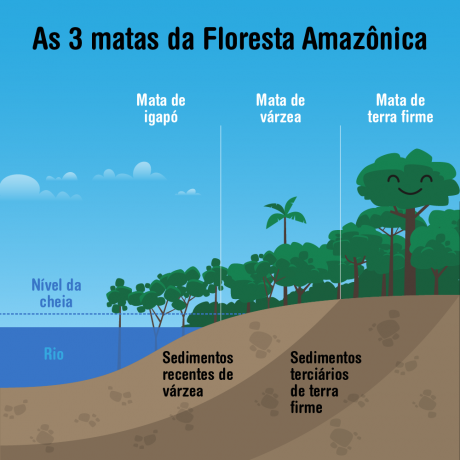
The latest data released by the IBGE, indicate that the North region of Brazil it has 450 municipalities, more than 17 million inhabitants, in addition to being the largest region in the country in terms of territorial extension (equivalent to 45% of the Brazilian territory).
The states belonging to the Northern region of Brazil are:
| state | capital |
| Acre (AC) | White River |
| Amapá (AP) | Macapa |
| Amazon (AM) | Manaus |
| Pará (PA) | Bethlehem |
| Rondônia (RO) | Porto Velho |
| Roraima (RR) | Good view |
| Tocantins (TO) | palms |
The main physical characteristics of the Northern region of Brazil are:
Index

In the North region, the highest altitude reliefs are located on the border of Brazil with Venezuela, Guyana and French Guiana, the other areas of the region have low altitude reliefs (around 300 meters of altitude).
According to Jurandyr Ross' classification, the North region has the following relief units:
the relief unit South Amazon Residual Plateaus (No. 7 on the map) is located in the states of Pará and Rondônia. The unity Plateau and Plateau of Parecis (No. 5) is located in a part of Rondônia, Plateaus and Mountains of Goiás-Minas (No. 9) is located in Tocantins and the Plateau and Plateau of the Parnaíba Basin (nº 3) is present in the state of Tocantins.
In these relief units iron, manganese and gold ores are mined.
See too:
Before we study the classifications of climates present in the North region, we must remember a rule basic, the closer the location is to the equator, the higher its temperature and rain. As the equator crosses the North region, the main characteristics will be intense heat and rain, we also need to pay attention to the fact that the winter in this region is not harsh or similar to the others. regions. The main literatures classified the equatorial climate and the tropical climate in the North region.
According to Professor Galvani, from the Department of Geography at USP, the equatorial climate occurs in the Amazon region, with an average temperature between 24°C and 26°C, the rainfall index is the highest in the country (over 2000 mm/year). During the winter, this region may receive the mPa (Atlantic polar mass), causing the phenomenon of cold, where the temperature can reach 10°C, which is unusual for the region.
The tropical climate is characterized by two well-defined seasons, the dry winter and the rainy summer.
The location of the Northern region of Brazil on the planet, the reception of trade winds (wet winds moving from a latitude close to 30° to the equator), high temperature and rainfall are factors that contributed to the formation of Amazonian vegetation, even though the soil is poor, it is formed by large trees (between 30 and 50 meters in height), are evergreen, that is, the leaves do not fall throughout the year, the treetops intertwine and form a canopy, this vegetation is home to great animal biodiversity and vegetable.
It is important to emphasize that this vegetation is present in nine countries in South America, the term Legal Amazon is designated the Amazonian vegetation belonging to the Brazilian territory. We must also pay attention to the fact that Amazonian vegetation may vary according to the location in which it is found, it is possible for the vegetation to be igapó, floodplain or terra firme forest.
The terra firme vegetation does not have contact with the water of the rivers in the region, even during the flood period, the floodplain it has contact with the river water only during the flood period, the igapó vegetation is submerged, located next to the rivers.

It is important to differentiate hydrographic region and hydrographic basin, the first term consists of a set of basins with similar characteristics, the second is the main river and its tributaries draining a certain region.
In the North region of Brazil there are three hydrographic regions:
Subscribe to our email list and receive interesting information and updates in your email inbox
Thanks for signing up.


